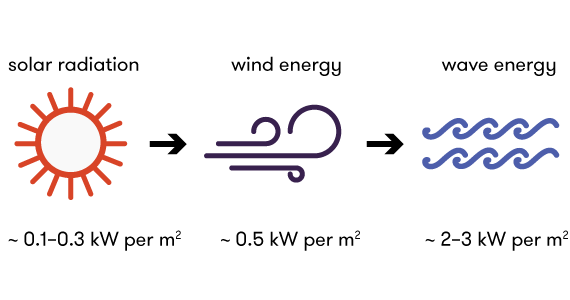Scientists are developing methods of harnessing the ocean’s kinetic energy to create electricity.
Covering more than two thirds of the earth and governed by churning waves and tides, the ocean is an intimidating power. In humanity’s tireless conquest of the earth’s natural resources, we are only beginning to harness the power of the ocean.
The ocean is unique because it contains sources of highly concentrated energy, such as waves and tides. Waves are formed when solar energy causes differences in air temperature, which in turn causes wind to blow. As the wind’s air molecules come into contact with the water, they cause friction between water molecules, which creates waves, a form of kinetic energy. The size and the speed of the waves are decided by water depth and seafloor topography (1). When solar energy converts to wind energy and wind converts to wave energy, the amount of energy per unit volume becomes more concentrated after each conversion, making the ocean a very dense source of energy.

In search of strategies to convert waves’ kinetic energy to electricity, scientists developed two distinct methods: oscillating water columns and oscillating bodies.
Oscillating water columns are large hollow columns half-submerged in water and use the ocean’s waves to force a stream of trapped air through an air turbine. When the water recedes, the air leaves the column. The movement of the air turns a turbine which turns a generator to create electricity. Oscillating water columns turn regardless of the direction of the air, making them highly efficient (2).
Oscillating bodies, the most common type of which are point absorber buoys, are fixed to the sea floor by a gearbox. As the point absorber buoy bobs, it activates a hydraulic pump which pushes water and air through a turbine, powering a generator (1).
Another type of kinetic energy in the ocean is tidal energy. Caused by the varying gravitational forces the moon exerts on the sea, tides are broadscale rises and falls in the level of the water (2). The immense kinetic energy of the tides can be harnessed using tidal turbines (1).
A tidal turbine has three blades which rotate with the ebb and flow of the tide. Similar to a wind turbine, a tidal turbine is connected to a gearbox, which rotates nearly 1,200 times per minute, and produces electricity (1).

Ocean energy is a renewable alternative to oil and gas, as it doesn’t produce any greenhouse gasses or pollution. It is scalable, as there is plenty of coastline space to build turbines. It also has a low cost of maintenance (1).
However, humanity still has many obstacles to face before they can harness the power of the ocean to create electricity. One of the reasons that scientists have been hesitant to extract energy from this ocean in such a manner is that the machinery is not yet fully resistant to storm damage, and the noise pollution and blades could disrupt marine habitats (1). Perhaps humanity cannot conquer the seas just yet, but scientists will continue to try to fulfill this dream.
Bibliography:
- Penesis, Irene. (2016, April 30). Harnessing the Power of the Ocean. Australian Academcy of Science. Retrieved from: https://www.science.org.au/curious/technology-future/ocean-power
- (2018). Oscillating Water Column. Science Direct. Retrieved from: https://www.science.org.au/curious/technology-future/ocean-power
- Severson, Wes. (2022, March 2). What’s the Difference between Waves and Tides? Wetsuit Wearhouse. Retrieved from: https://www.wetsuitwearhouse.com/blog/whats-the-difference-between-waves-and-tides/#:~:text=Quick%20Differences&text=Tides%20are%20the%20rise%20and,of%20wind%20or%20other%20forces.
Images:
